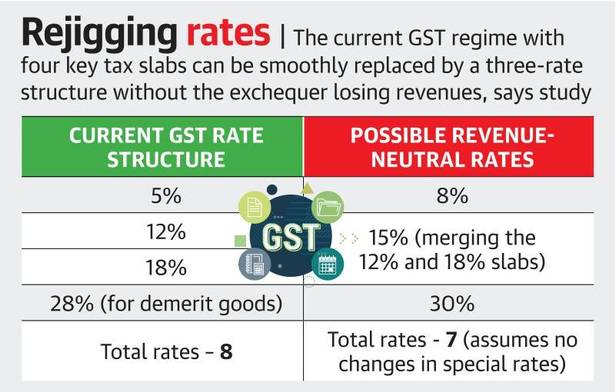Need for GST Rate Reset

How is the current GST system structured?
- The GST system was introduced in 2017 for the simplification of the taxation system.
- It subsumed a number of state and central levies.
- The original revenue-neutral tax rates were 15.5% to 11.6%. This has changed due to rate cuts in different categories since 2017.
- There are 8 effective GST rates. These include:
- Zero rate on essential goods
- The 4 major rates of 5%, 12%, 18% and 28%
- 28% tax plus GST Compensation Cess for sin goods
- Special low rates for precious stones, jewellery and supplies to exporters
Why is a reset needed?
- The GST system has been facing criticism, from its onset, for having too many tax rates– leaving the taxation liable for complications.
- Several of these rate changes were due to the hasty beginning of the GST regime and errors in initial rate-setting.
- The GST Council has been resolving the hardships caused by these changes for the industry segments. However, the constant alterations have changed the originally envisaged revenue dynamics.
- The government had hinted that the rates would be reviewed after the system stabilizes.
- Though the monthly GST collections have been healthy, the revenue is falling short of the expectation.
- The GST Council had set up a Group of Ministers with the task of:
-
- Proposing changes such as merging tax slabs
- Preparing a roadmap for the changes in the immediate, short- and medium-term
What are the recommendations of the NIPFP study?
- The National Institute of Public Finance and Policy recently released a paper calling for a 3-rate framework to rejig the 4 major rates.
- This framework envisages 3 rates- 8%, 15% and 30%.
- The 18% rate currently accounts for the largest taxable turnover. This is levied even on insurance premium payments.
- There will be revenue losses if the 18% slab is to be reduced or merged with the 12% segment. This would then have to be offset by increases in the lowest (5%) rate or the highest rate (28%).
- The 3-rate framework would help protect revenue while leaving the special rates undisturbed and minimizing the need for drastic hikes in either end of the tax spectrum.
What is the way ahead?
- With the GST now in its 5th year, the government has decided that the time is ripe for rate reset.
- The 3-rate framework proposal is less contentious than the one proposed to the GoM- i.e. raising rates on bullion. Such a move could trigger tax evasion.
- In order to keep disruptions to a minimum and gain investor confidence, 2 things are critical:
-
- Sequencing the implementation of new tax rates
- Avoiding frequent tweaks in the rates
- Next month, the GST Council is set to meet and decide on the restructuring exercise.
- In addition to this, the GST Council must address data limitations that have been highlighted by the NIPFP paper.
Conclusion:
The restructuring of GST rates would be a timely move, not only to improve the revenue but also to reduce complications for the industries arising from frequent tweaking of rates. However, with the state polls approaching, the government’s resolve to carry out such a key restructuring is set to be tested.
Referred Sources
If you like this post, please share your feedback in the comments section below so that we will upload more posts like this.


